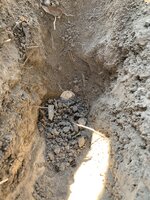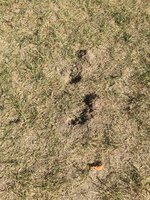Have you ever watched a detectorist that is known as a pro hunt?
He usually does not drop and start digging 12 inch deep holes but
moves around the area he is hunting digging rather shallow holes
and usually has a larger trash bag and a smaller container that he keeps using
every so often...that is his keeper container and he uses it often.
He does not spend a whole lot of time in one area but when he does he seems to
detect it in circles or back and forth across the same area.
Many times across it...back and forth...and then out comes the long
handle digger, and then the 12 inch digging begins.
To succeed in a situation such as iron/nail infested areas shouldn't we use a
lower sensitivity setting to get the coins lying within the 8 inch range as most
claim that all the good coins they find are no deeper than 8 inches?
A higher sensitivity may mask these easier to get coins, making them invisible to
a detector running at max sensitivity depth for their chosen coil.
This can mean that a large coil, at max setting, would miss a coin close to trash
while a lower setting would be a better footprint to actual hit the 8 inch coin.
This could also be used as a way to locate a coin hotspot, where after the lower
sensitivity is used, you could go up to the max setting for your coil and re-hunt
for deeper coins in a known productive place.
Sure we all want to dig the deep coins, but we all like shallow digs for silver too,
And it is a whole lot easier to locate and recover targets within the 8 inch range.
He usually does not drop and start digging 12 inch deep holes but
moves around the area he is hunting digging rather shallow holes
and usually has a larger trash bag and a smaller container that he keeps using
every so often...that is his keeper container and he uses it often.
He does not spend a whole lot of time in one area but when he does he seems to
detect it in circles or back and forth across the same area.
Many times across it...back and forth...and then out comes the long
handle digger, and then the 12 inch digging begins.
To succeed in a situation such as iron/nail infested areas shouldn't we use a
lower sensitivity setting to get the coins lying within the 8 inch range as most
claim that all the good coins they find are no deeper than 8 inches?
A higher sensitivity may mask these easier to get coins, making them invisible to
a detector running at max sensitivity depth for their chosen coil.
This can mean that a large coil, at max setting, would miss a coin close to trash
while a lower setting would be a better footprint to actual hit the 8 inch coin.
This could also be used as a way to locate a coin hotspot, where after the lower
sensitivity is used, you could go up to the max setting for your coil and re-hunt
for deeper coins in a known productive place.
Sure we all want to dig the deep coins, but we all like shallow digs for silver too,
And it is a whole lot easier to locate and recover targets within the 8 inch range.


